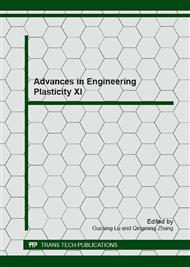p.89
p.94
p.101
p.105
p.109
p.113
p.117
p.121
p.125
A Constitutive Description of the Yield Strength and Strain Hardening Behaviors of Nano-Twinned Metals
Abstract:
In this paper, a constitutive description of the true stress-strain behaviors of nano-twinned metals has been proposed. The size effects of nano-scale twin boundaries (TBs) and ultra-fine grain boundaries (GBs) are considered in the athermal stress. The evolution of the dislocation density with strain under the influence of strain rate and temperature is introduced in the thermal stress based on our previous meso-scale constitutive model. The new model can effectively describe the strength transition regime in nano-twinned metals. The proposed model’s predictions of true stress-strain relation curves for nano-twinned copper are compared with the experimental results of uniaxial tension tests for validation. The comparisons show that the previous models in literature for the dependence of initial yield strength on twin spacing cannot describe the experimental data correctly when the twin spacing tends to zero; however, the phenomenological model proposed in this paper for the twin spacing depending relation is theoretically rational and can well describe the experimental data in the whole range of twin spacing.
Info:
Periodical:
Pages:
109-112
Citation:
Online since:
January 2013
Authors:
Keywords:
Price:
Сopyright:
© 2013 Trans Tech Publications Ltd. All Rights Reserved
Share:
Citation:


